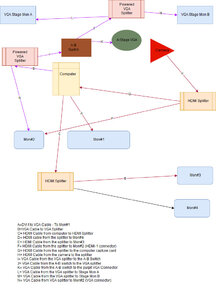WilliamJones
n00b
- Joined
- Aug 19, 2018
- Messages
- 63
Our church has a complicated system which I inherited and have even added a few things to. I have a question for the experts, and I will describe it and put a list of hardware at the end of the post.
We are live streaming using OBS to YouTube, plus capturing video to the computer. CPU load during this process is 15-20%.
The camera sends video via HDMI to a powered HDMI splitter. One output goes to the capture card. The other output goes to the 17” monitor on the desk.
The VGA output from the video card goes to a powered VGA splitter on the desk. The first output goes to the 17” monitor on the desk. The second output goes to an A-B switch. The first output from the A-B switch goes to a powered VGA splitter all the way up to the stage where there are 2 large screen monitors. The second output from the A-B switch goes to the pulpit where a speaker can plug his laptop in to project to the two stage monitors.
The DVI output from the video card goes to the HDMI port on the 34” wide screen monitor on the desk via a cable with DVI on one end and HDMI on the other.
The HDMI output on the video card goes to a powered HDMI splitter. The first output goes to one of the Sharp 55” external monitors. The second output goes to the second 55” external monitor.
So far, this system works just fine, although the resolution on the three VGA monitors needs to be kept below 1080x720, otherwise they will blink and one turns from full color to pink and red. This may be telling me we are maxed out on our video card.
I was told they want to add a third 55” monitor in a room that is about 100 feet away. I told them that we will need to use SDI cable with converters at both ends.
Question:
Will I be able to add a third large screen monitor, and if not, will it be because of the video card or the CPU, or both?
Hardware:
Desktop computer with an i5-4670 with 16GB ram.
Video card: nVidia GT730 with 2GB ram, 40GB memory bandwidth, 3 ports – DVI, VGA, HDMI (simultaneous output)
Avermedia Capture Card
A&H MixWizard 16:2 sound board
34” Wide screen monitor (#1) on the desk, HDMI input
17” Monitor (#2) on the desk, Inputs: HDMI1, HDMI2, VGA (NOT simultaneous) This is used primarily to duplicate what is seen on the 2 stage monitors.
Sony camera with HDMI output
2 each large screen monitors on the stage
1 Sharp 55” HDMI external monitor in an overflow room. 5 years old
1 Sharp 55” HDMI external monitor in an overflow room. 2 days old
We are live streaming using OBS to YouTube, plus capturing video to the computer. CPU load during this process is 15-20%.
The camera sends video via HDMI to a powered HDMI splitter. One output goes to the capture card. The other output goes to the 17” monitor on the desk.
The VGA output from the video card goes to a powered VGA splitter on the desk. The first output goes to the 17” monitor on the desk. The second output goes to an A-B switch. The first output from the A-B switch goes to a powered VGA splitter all the way up to the stage where there are 2 large screen monitors. The second output from the A-B switch goes to the pulpit where a speaker can plug his laptop in to project to the two stage monitors.
The DVI output from the video card goes to the HDMI port on the 34” wide screen monitor on the desk via a cable with DVI on one end and HDMI on the other.
The HDMI output on the video card goes to a powered HDMI splitter. The first output goes to one of the Sharp 55” external monitors. The second output goes to the second 55” external monitor.
So far, this system works just fine, although the resolution on the three VGA monitors needs to be kept below 1080x720, otherwise they will blink and one turns from full color to pink and red. This may be telling me we are maxed out on our video card.
I was told they want to add a third 55” monitor in a room that is about 100 feet away. I told them that we will need to use SDI cable with converters at both ends.
Question:
Will I be able to add a third large screen monitor, and if not, will it be because of the video card or the CPU, or both?
Hardware:
Desktop computer with an i5-4670 with 16GB ram.
Video card: nVidia GT730 with 2GB ram, 40GB memory bandwidth, 3 ports – DVI, VGA, HDMI (simultaneous output)
Avermedia Capture Card
A&H MixWizard 16:2 sound board
34” Wide screen monitor (#1) on the desk, HDMI input
17” Monitor (#2) on the desk, Inputs: HDMI1, HDMI2, VGA (NOT simultaneous) This is used primarily to duplicate what is seen on the 2 stage monitors.
Sony camera with HDMI output
2 each large screen monitors on the stage
1 Sharp 55” HDMI external monitor in an overflow room. 5 years old
1 Sharp 55” HDMI external monitor in an overflow room. 2 days old
![[H]ard|Forum](/styles/hardforum/xenforo/logo_dark.png)
